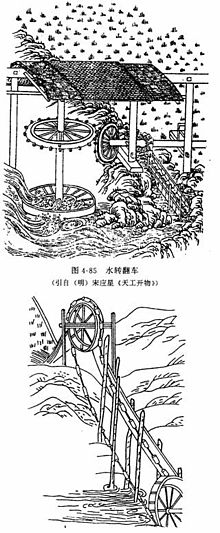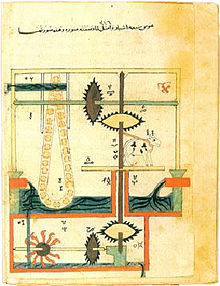- Chain pump
-
The chain pump is type of a water pump in which several circular discs are positioned on an endless chain. One part of the chain dips in to the water, and the chain runs through a tube, slightly bigger than the diameter of the discs. As the chain is drawn up the tube, water becomes trapped between the discs and is lifted to and discharged at the top. Chain pumps were used for centuries in the ancient Middle East, Europe, China, and ancient Egypt.
Contents
In the Middle East and Rome
The earliest evidence for this device is in a Babylonian text from about 700 B.C.. These were commonly powered by humans or animals.[1] The device then appeared in ancient Egypt from about 200 B.C., featuring a pair of gear-wheels.[2]
A version of the chain pump was used in Ancient Roman times, sometimes with pots fixed to the chain, which, as they passed over the top pulley, tipped the water out. Philo of Byzantium wrote of such a device in the 2nd century B.C.; the historian Vitruvius mentioned it around 30 B.C. Fragments of these buckets were found on the Roman barges of Lake Nemi.[3]
Complex chain pumps consisting of more than 200 separate components were used extensively by Muslim inventors and engineers in the medieval Islamic world, where they are known as saqiya.[2] The mechanical flywheel, used to smooth out the delivery of power from a driving device to a driven machine, was first employed by Ibn Bassal (fl. 1038–1075), of Islamic Spain, in a saqiya chain pump.[4][unreliable source?]
A manuscript by Al-Jazari featured an intricate device with chambered reservoirs, water-wheel scoops, gear-wheels, and a chain pump, powered by the pull of an ox and falling water.[5] The first known use of a crankshaft in a chain pump was featured in another one of al-Jazari's saqiya machines.[6][verification needed] The concept of minimizing the intermittency is also first implied in one of al-Jazari's saqiya chain pumps, which was to maximise the efficiency of the saqiya chain pump.[6] Al-Jazari also constructed a water-raising saqiya chain pump that was run by hydropower rather than manual labour, though the Chinese were also using hydropower for chain pumps before him. Saqiya machines like the ones he described have been supplying water in Damascus since the 13th century,[7][unreliable source?] and were in everyday use throughout the medieval Islamic world.[6]
Chain pumps were used in European mines during the Renaissance; mineralogist Georg Agricola illustrated them in his De re metallica (1556).[8] They were used in dockyards, and several formed part of the Portsmouth Block Mills complex.[citation needed] Chain pumps were commonly used on naval vessels of the time to pump the bilges, and examples are known in the nineteenth century for low-lift irrigation.
 Two types of hydraulic-powered chain pump from the Chinese encyclopedia Tiangong Kaiwu (1637), written by Song Yingxing.
Two types of hydraulic-powered chain pump from the Chinese encyclopedia Tiangong Kaiwu (1637), written by Song Yingxing.
Square-pallet in China
Chain pumps were also used in ancient China by at least the 1st century A.D. In China, they were also called dragon backbones.[9] One of the earliest accounts was a description by the Han Dynasty philosopher Wang Chong (A.D. 27–97) around A.D. 80.[10] Unlike those found in the West, chain pumps in China resembled the square-pallet type instead of the pear-shaped bucket. Illustrations of such Chinese chain pumps show them drawing water up a slanted channel. These were sometimes powered by hydraulics of a rushing current against a horizontal water wheel acting against a vertical wheel,[11] and others by a horizontal mechanical wheel acting upon a vertical wheel that was pulled by the labor of oxen.[12] There were also square-pallet chain pumps operated by pedals.[13]
From the 1st century onwards, chain pumps were widespread throughout the Chinese countryside.[14] Chinese square-pallet chain pumps were used mostly for irrigation, though they found use in public works as well. The infamous Eastern Han court eunuch Zhang Rang (d. A.D. 189) once ordered the engineer Bi Lan (畢嵐) to construct a series of square-pallet chain pumps outside the capital city Luoyang.[15] These chain pumps serviced the palaces and living quarters of the Luoyang; the water lifted by the chain pumps was brought in by a pipe system.[15] Ma Jun, the renowned mechanical engineer of the Three Kingdoms era, also constructed a series of chain pumps for watering the palatial gardens of Emperor Ming of Wei (226–239).[16]
From the 13th century onwards, the Chinese also used windmills (adopted from the Islamic world) to power square-pallet chain pumps.[17] Yet there were other types of chain pumps besides the square-pallet design. In Song Yingxing's (1587–1666) encyclopedic book the Tiangong Kaiwu (1637), there is description and illustration of a cylinder chain pump, powered by waterwheels and leading water up from the river to an elevated plain of agricultural crops.[18]
See also
Notes
- ^ Joseph Needham, Science and Civilisation in China 4(2) (1965), p. 352.
- ^ a b Donald Routledge Hill (1996), "Engineering", in Roshdi Rashed, Encyclopedia of the History of Arabic Science, Vol. 3, pp. 751–795 [771].
- ^ Needham, Volume 4, Part 2, p. 109.
- ^ Ahmad Y Hassan, Flywheel Effect for a Saqiya, History of Science and Technology in Islam
- ^ Needham, Volume 4, Part 2, p. 353.
- ^ a b c Donald Routledge Hill, "Engineering", p. 776, in Roshdi Rashed, ed., Encyclopedia of the History of Arabic Science, Vol. 2, pp. 751–795, Routledge, London and New York
- ^ Ahmad Y Hassan, Al-Jazari and the History of the Water Clock
- ^ G. Agricola, In Re Metallica, <page needed>.
- ^ Needham, Volume 4, Part 2, 89, 110.
- ^ Needham, Volume 4, Part 2, p. 344.
- ^ Needham, Volume 4, Part 2, pp. 342–343.
- ^ Needham, Volume 6, Part 2, p. 500.
- ^ Needham, Volume 4, Part 2, pp. 340–341.
- ^ Needham, Volume 4, Part 2, p. 110.
- ^ a b Needham, Volume 4, Part 2, p. 33.
- ^ Needham, Volume 4, Part 2, p. 40.
- ^ Needham, Volume 4, Part 2, p. 558.
- ^ Song, 15.
References
- Needham, Joseph (1986). Science and Civilization in China: Volume 4, Physics and Physical Technology, Part 2, Mechanical Engineering. Taipei: Caves Books, Ltd.
- Needham, Joseph (1986). Science and Civilization in China: Volume 6, Biology and Biological Technology, Part 2, Agriculture. Taipei: Caves Books Ltd.
- Song, Yingxing, translated with preface by E-Tu Zen Sun and Shiou-Chuan Sun (1966). T'ien-Kung K'ai-Wu: Chinese Technology in the Seventeenth Century. University Park: Pennsylvania State University Press.
Categories:- Pumps
- Traditional Chinese objects
- Hydraulics
Wikimedia Foundation. 2010.

